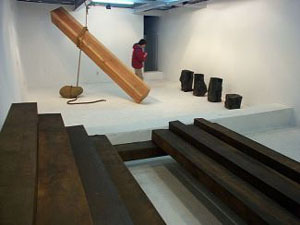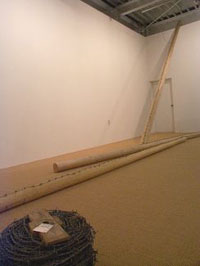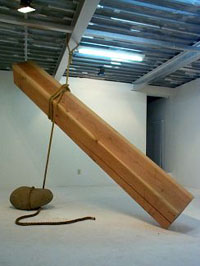Born in the year of global student discontent, Mono-ha is as much about the forces, political as well as physical, that shape our environment. An excellent selection of Mono-ha art from the late sixties and early seventies is on display at the Kamakura Gallery, Kamakura. While Sekine Nobuo's hole, which was a site specific work created for the Biennale of Kobe, is not among them, other work by him are featured. The exhibition of about twenty works by eight artists has previously toured Europe and the USA.
It includes a few original works from the period, as well as, others, which have been re-created by the artists more recently. The exhibition Curator and gallery owner, Michiko Nakamura, is an authority on the movement and has been involved with the artists over a long period.
Using materials such as stone, lumber, burnt wood, sheet steel, wax, glass, rope, rusted plate steel, cloth, sand and Japanese papers, Mono-ha artists created a raw art -- art that is immediate and forceful. Cut Off (Hang) made by Yoshida Katsuro in 1969 is a huge wooden beam hung from a roof rafter and secured mid air, by a thick rope. The rope is looped about a large smooth river rock. Friction between wood, rock and rope counter-balance gravity. Cut Off encapsulates many of the key elements of Mono-ha. It is on the one hand simply about the "things", the lump of wood and rock and the very direct confrontation the viewer has when standing in front of this suspended mass of lumber. It is, however, also about the void -- what is underneath and around it -- an encounter with the totality of the site and all of the forces at play.
Another artist in the group Koshimizu Susumu used Japanese paper to make a bag in which a large rock is contained. The work wraps objects, vastly different in substance, through association with a common Japanese children's game. Sekine Nobuo is represented by works made from oil clay formed into organic lumps. Takayama Noboru uses wooden railway sleepers to construct steps and shapes in his 2 tonne work in the exhibition.
Perhaps best known of the group is the artist and writer Lee U-Fan. His work on display at Kamakura like many of his other pieces uses large garden rocks. These rocks prop up rusted metal steel plates or rest asleep in a bed of cotton wool, creating Zen-like- meditations. This was a seminal period for Japanese contemporary art and the Kamakura exhibition is a rare opportunity to see and experience this powerful art movement.


